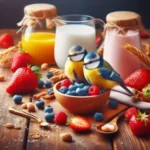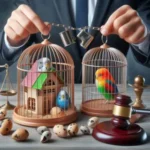Transforming your backyard into a haven for local wildlife can be a rewarding and delightful experience, especially when you invite our feathered friends to visit.
Imagine the joy of watching vibrant birds flit about, chirping and singing as they enjoy the treats you’ve thoughtfully provided. In this blog post, we will guide you through the process of crafting a simple yet charming DIY bird feeder that not only adds a touch of creativity to your outdoor space but also promotes a deeper connection with nature. With just a few materials and some easy-to-follow steps, you can create a functional and stylish feeder that will attract a variety of birds right to your window. Whether you’re an experienced crafter or a beginner, this project is perfect for anyone looking to enhance their backyard experience while contributing to the well-being of local wildlife. So, gather your supplies and let’s embark on this delightful crafting adventure together!
1. Introduction: The Joy of Bird Watching
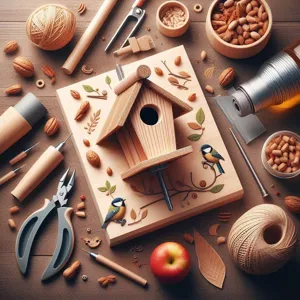
Bird watching is more than just a pastime; it’s a delightful journey into the vibrant world of nature that can transform your backyard into a lively sanctuary. Imagine sipping your morning coffee while colorful songbirds flit about, their cheerful melodies filling the air. The gentle flutter of wings and the soft chirping create an enchanting atmosphere that invites calm and contemplation.
Creating a space where birds feel welcome not only enhances the beauty of your outdoor environment but also fosters a deeper connection with the natural world. Whether you’re a seasoned bird enthusiast or a curious beginner, the thrill of spotting a new species at your feeder is unmatched. From the spirited chirps of sparrows to the striking plumage of cardinals, each bird brings its own charm and character.
In this blog post, we’ll guide you through crafting a simple bird feeder that will invite these delightful creatures into your backyard. With just a few materials and a sprinkle of creativity, you can create a cozy dining spot for our feathered friends. Get ready to embrace the joy of bird watching and witness the magic of nature unfold right outside your window!
2. Benefits of Feeding Birds in Your Backyard
Feeding birds in your backyard offers a wealth of benefits that enrich not just the avian visitors but also your own outdoor experience. First and foremost, attracting birds brings a vibrant splash of life to your garden. The cheerful chirping and fluttering of wings create a joyful symphony that transforms your outdoor space into a lively sanctuary. Imagine sipping your morning coffee while observing colorful finches, majestic cardinals, or playful chickadees flit about, each adding their unique charm to your surroundings.
Beyond the aesthetic pleasure, feeding birds also plays a crucial role in supporting local ecosystems. During harsh weather conditions or when natural food sources are scarce, your bird feeder becomes a lifeline for these creatures. By providing a reliable food source, you contribute to their survival, helping to sustain populations of beneficial species that can aid in pest control and pollination in your garden.
Moreover, birdwatching can be a therapeutic and educational experience. It fosters a deeper connection with nature and encourages mindfulness as you observe the various species and their behaviors. Children and adults alike can learn about the different types of birds, their diets, and their habits, inspiring a greater appreciation for wildlife and the environment.
Lastly, feeding birds can also have a positive impact on your garden. Many birds are natural pest controllers, feasting on insects that might otherwise harm your plants. This can lead to a healthier and more robust garden ecosystem, allowing your flowers and vegetables to thrive without the heavy reliance on chemical pesticides.
In summary, the simple act of feeding birds not only beautifies your backyard but also supports local wildlife, enhances personal well-being, and promotes ecological balance. With each seed you scatter, you’re not just inviting feathered friends; you’re nurturing a vibrant, interconnected world right outside your door.
3. Materials Needed for Your DIY Bird Feeder
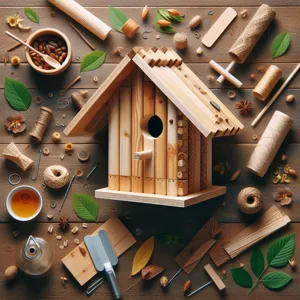
Creating a DIY bird feeder is not only a rewarding project but also a wonderful way to invite nature into your backyard. To get started, you’ll need a few simple materials that are likely already lying around your home or are easily accessible at your local craft store.
**1. A Plastic Bottle:** A standard two-liter soda bottle works perfectly for this project. Its lightweight and durable design makes it an ideal choice for holding birdseed while allowing birds to perch comfortably. If you don’t have a soda bottle, any empty plastic container with a lid will suffice.
**2. Wooden Dowels or Sticks:** These will serve as perches for the birds. Look for dowels that are about ¼ inch in diameter and a foot long. If you don’t have dowels, sturdy twigs can work just as well.
**3. Birdseed:** Opt for a mix that attracts a variety of birds, such as sunflower seeds, millet, and safflower. You can also include nuts and dried fruit to appeal to different species.
**4. Drill or Scissors:** You’ll need a tool to make holes in the plastic bottle for the perches and for the birdseed to dispense. A drill with a small bit works best, but if you’re using scissors, be sure to exercise caution when cutting.
**5. String or Wire:** This will be used to hang your bird feeder. Choose a durable material that can withstand outdoor conditions. If you opt for string, make sure it’s thick enough to support the weight of the feeder.
**6. Paint or Markers (optional):** If you want to add a decorative touch, non-toxic paint or permanent markers can be used to personalize your feeder. Bright colors can attract birds while adding a whimsical flair to your yard.
Once you have gathered these materials, you’ll be well on your way to creating a charming and functional bird feeder that not only benefits local wildlife but also enhances your outdoor space with beauty and liveliness. Get ready to watch the birds flock to your backyard!
4. Step-by-Step Instructions to Build Your Bird Feeder
Creating a charming bird feeder for your backyard is a rewarding DIY project that not only enhances your outdoor space but also invites delightful feathered friends to visit. Follow these step-by-step instructions to craft a simple yet effective bird feeder that will attract a variety of birds all year round.
**Materials Needed:**
– A clean, empty plastic bottle (such as a 1-liter soda bottle)
– Two wooden dowels or sturdy sticks (about 6-8 inches long)
– Birdseed (your choice of seed mix)
– A small piece of wire or string for hanging
– A sharp knife or scissors
– A funnel (optional, but helpful for filling)
**Step 1: Prepare the Bottle**
Begin by thoroughly cleaning your plastic bottle to ensure it’s free of any residue. Once it’s dry, use your knife or scissors to carefully cut small holes on opposite sides of the bottle, about 2-3 inches from the bottom. These holes should be just large enough to fit the wooden dowels, which will serve as perches for the birds.
**Step 2: Insert the Perches**
Take your wooden dowels and insert them through the holes you just created. This will allow the birds to land comfortably as they enjoy the seeds. Ensure that the dowels are secure and protrude evenly from the sides of the bottle.
**Step 3: Create a Seed Dispenser**
Next, use your knife to make a few small holes towards the bottom of the bottle. These holes should be slightly larger than the birdseed, allowing it to flow out when the feeder is full. The downward slope of the bottle will help the seeds move towards these openings.
**Step 4: Fill the Feeder**
Using a funnel (or simply your hands), fill the bottle with your chosen birdseed. Avoid overfilling, as this may cause the seeds to clog the dispensing holes. Leave some space at the top to allow for easy refilling.
**Step 5: Attach the Hanging Mechanism**
To hang your bird feeder, take a piece of wire or string and create a loop around the neck of the bottle, securing it tightly. This will allow you to easily suspend your feeder from a tree branch or hook in your yard.
**Step 6: Find the Perfect Spot**
Now that your bird feeder is ready, it’s time to hang it up! Choose a visible location in your backyard, ideally near some shrubbery or trees, where birds can feel safe while feeding. Make sure it’s also within view from your favorite window, so you can enjoy the show.
**Step 7: Maintenance and Enjoyment**
Regularly check your bird feeder to refill the seeds and clean it when necessary. Keep an eye out for the various bird species that come to visit, and enjoy the peaceful atmosphere they bring to your backyard.
By following these simple steps, you’ll have a charming bird feeder that not only beautifies your outdoor space but also supports local wildlife. Get ready to embrace the joy of birdwatching right from your home!
5. Choosing the Right Location for Your Feeder
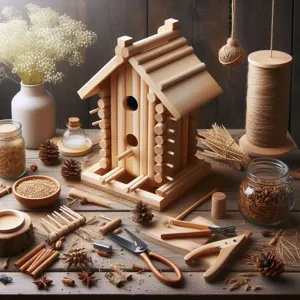
Choosing the right location for your bird feeder is crucial to attracting a diverse range of feathered friends to your backyard. A well-placed feeder not only enhances your birdwatching experience but also ensures the safety and enjoyment of the birds visiting your garden. Here are some essential factors to consider when deciding where to hang your new creation.
First and foremost, think about visibility. Select a spot where you can easily view the feeder from a window or your patio. This will allow you to enjoy the delightful antics of your avian visitors up close. Ideally, position the feeder about 5 to 10 feet away from any structures, such as trees, fences, or buildings, to give birds enough space to feel safe while feeding. This distance helps prevent predators, like cats or hawks, from launching surprise attacks.
Light is another vital aspect to consider. Birds prefer feeders that are situated in a moderately sunny area, as sunlight provides warmth and visibility. However, avoid placing the feeder in full, blazing sunlight, as this can cause the seeds to spoil more quickly. A location with dappled sunlight or morning sun is often ideal, allowing birds to feed comfortably while keeping the seeds fresh.
Additionally, consider the surrounding environment. Ideally, your feeder should be located near natural cover, such as shrubs or bushes, which offer birds a quick getaway from potential threats. These hiding spots not only provide a sense of security but also serve as resting places for birds as they survey the area before approaching the feeder.
Lastly, think about accessibility for yourself. Choose a location that allows for easy refilling and cleaning of the feeder without too much hassle. A spot that’s easily reachable will encourage you to maintain the feeder regularly, ensuring it remains a welcoming haven for your backyard guests.
By thoughtfully considering these factors, you’ll create an inviting space that attracts an array of birds and transforms your backyard into a lively sanctuary filled with color and song. So gather your materials, hang that feeder, and get ready for the delightful show that nature has in store for you!
6. Different Types of Bird Feed to Use
When it comes to attracting a diverse array of feathered friends to your backyard, the type of bird feed you choose can make all the difference. Different birds have different dietary preferences, and offering a variety of feeds can draw in a colorful cast of characters to your new bird feeder. Here are some popular options to consider:
1. **Seed Mixes**: A standard birdseed mix is a great starting point. Look for blends that include sunflower seeds, millet, and cracked corn, which are favorites among many birds, including finches, sparrows, and cardinals.
2. **Sunflower Seeds**: These are a top choice for many backyard birds, especially larger species like chickadees and jays. Black oil sunflower seeds, in particular, are rich in fat and have thinner shells, making them easier for smaller birds to crack open.
3. **Nyjer (Thistle) Seeds**: These tiny seeds are a magnet for goldfinches and other small birds. Nyjer feeders are specifically designed for these seeds, featuring small holes that prevent the seeds from spilling out.
4. **Peanuts**: Unsalted, shelled peanuts are a high-protein option that attracts jays, woodpeckers, and nuthatches. You can scatter them on the ground or offer them in a platform feeder for easy access.
5. **Suet**: Suet cakes are a fantastic treat for insect-eating birds like woodpeckers and wrens. These high-energy snacks are typically made from animal fat mixed with seeds or nuts and can be hung in specialized suet feeders.
6. **Fruit**: Don’t forget about fresh fruit! Slices of apples, oranges, or berries can lure in fruit-loving birds such as orioles and mockingbirds. Simply skewer the fruit onto a branch or use a hanging feeder designed for this purpose.
7. **Mealworms**: If you want to attract bluebirds or wrens, consider offering dried mealworms. These protein-rich treats are especially appealing during nesting season when birds need extra energy for themselves and their chicks.
By diversifying the types of bird feed you offer, you not only increase the chances of spotting various species but also create a lively and entertaining atmosphere in your backyard. Remember, it’s not just about feeding the birds; it’s about creating a thriving ecosystem that you can enjoy throughout the seasons. So, stock up on these bird feed options, grab your DIY bird feeder, and get ready to welcome your new avian visitors!
7. Tips for Attracting a Variety of Bird Species
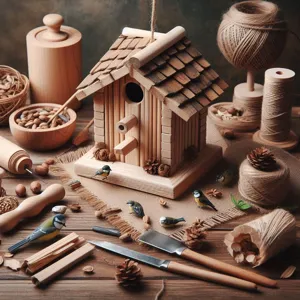
Creating a welcoming environment for a diverse range of bird species can transform your backyard into a lively oasis of chirps and flutters. Here are some practical tips to attract various feathered friends to your newly crafted bird feeder.
**1. Choose the Right Feed:** Different bird species have distinct dietary preferences. For instance, finches enjoy nyjer (thistle) seeds, while woodpeckers favor suet. Consider offering a mix of seeds, including sunflower seeds, millet, and peanuts, to cater to a broader audience. A seed blend specifically designed for mixed birds can work wonders, ensuring that you appeal to a variety of species.
**2. Vary Your Feeders:** To attract different birds, use a combination of feeder types. Tube feeders are great for smaller birds, while platform feeders can accommodate larger species. Suet feeders are essential for attracting woodpeckers and other insectivores. By diversifying your feeders, you create an inviting buffet for your avian visitors.
**3. Add Water Sources:** Birds need water for drinking and bathing, making a birdbath an excellent addition to your backyard. Ensure it has clean, fresh water and consider adding pebbles or shallow stones for smaller birds to perch on. Changing the water regularly will not only keep it clean but also encourage birds to return frequently.
**4. Create a Safe Space:** Birds seek safety from predators, so providing shelter near your feeder is crucial. Planting native shrubs and trees can offer natural cover and nesting spots. The more natural the environment, the more likely birds will feel secure enough to visit your feeder.
**5. Keep Your Feeder Clean:** Regular maintenance of your feeder is essential for attracting birds. Clean it every couple of weeks to prevent mold and bacteria from building up. A clean feeder ensures that the food remains fresh and appealing, encouraging birds to return time and again.
**6. Be Patient and Observant:** Attracting a variety of birds takes time, so be patient. Keep an eye on your feeder and jot down any visitors you see. This not only enhances your birdwatching experience but also gives you insights into which species are drawn to your feeder, allowing you to tailor your offerings accordingly.
By implementing these tips, you’ll not only provide a nourishing sanctuary for your feathered friends but also create a delightful experience for yourself as you watch the vibrant dance of nature unfold in your backyard. Happy birdwatching!
8. Maintenance: Keeping Your Bird Feeder Clean and Functional
Maintenance is key to ensuring your bird feeder remains a welcoming oasis for our feathered friends. A clean feeder not only promotes the health and safety of the birds but also enhances your enjoyment of the birdwatching experience. Over time, leftover seeds, droppings, and debris can accumulate, creating an unsightly and potentially hazardous environment.
To keep your bird feeder in top shape, make it a habit to inspect it regularly—ideally once a week. First, empty any remaining seeds, and give the feeder a thorough cleaning. A mixture of warm water and mild soap works wonders; scrub the feeder with a soft brush to remove any mold or mildew that may have formed. Rinse it well to ensure no soap residue lingers, as this can be harmful to birds.
For wooden feeders, consider sealing them with a non-toxic wood preservative to protect against the elements, but remember to clean them often to prevent rot. Plastic feeders can usually withstand the elements, but sunlight can cause them to become brittle over time. If you notice any cracks or damage, it’s best to replace the feeder to ensure safety for the birds.
Additionally, consider the type of seed you’re using. Some seeds, especially those high in oil content, can spoil more quickly. Opt for seeds that are less likely to go rancid and consider rotating them frequently to keep them fresh.
Lastly, don’t forget to monitor the feeder’s placement. Ensure it’s positioned in a safe spot away from potential predators, yet close enough to provide shelter and visibility for your avian guests. By committing to routine maintenance and care, your backyard bird feeder can become a thriving hub of activity, attracting a variety of birds and bringing joy to your outdoor space for years to come.
9. Seasonal Considerations for Bird Feeding
When it comes to bird feeding, understanding the seasonal dynamics can greatly enhance your backyard experience. Each season presents unique challenges and opportunities for attracting various bird species, making it crucial to tailor your feeding strategies accordingly.
**Spring:** As winter fades and warmer weather approaches, birds become increasingly active, seeking food to fuel their nesting efforts. This is the ideal time to offer a variety of seeds, such as sunflower hearts and nyjer seeds, which are particularly appealing to finches and other small birds. Consider adding suet cakes to provide high-energy nutrition for birds like woodpeckers and chickadees. Additionally, make sure to keep your feeders clean and well-stocked to support the influx of feathered visitors.
**Summer:** In the heat of summer, birds require ample hydration alongside their food sources. Incorporating a shallow birdbath or a water feature near your feeder can attract birds looking for a refreshing drink or a place to cool off. During these months, opt for seed mixes that include millet and cracked corn, which are favorites among ground-feeding birds. You can also hang fruit, like orange halves or grape clusters, to entice summer residents like orioles and tanagers.
**Fall:** As the days begin to shorten and temperatures drop, many birds enter a phase of migration, while others prepare for winter. This is a crucial time to offer high-calorie foods, such as peanuts and sunflower seeds, to help them build up fat reserves. Be mindful of the types of feeders you use; tube feeders are ideal for smaller birds, while platform feeders can accommodate larger species that may be gathering for winter.
**Winter:** When the landscape becomes blanketed in snow, birds face increased challenges in finding food. Your backyard can become a vital refuge for many species during this harsh season. Fill your feeders with high-energy seeds, suet, and even kitchen scraps like unsalted peanuts and dried fruits. Consider adding a heated birdbath to your setup to provide a constant source of water, which can be scarce in freezing temperatures.
By adjusting your bird feeding practices to align with the seasons, you’ll not only create a welcoming haven for backyard birds but also enjoy the beauty and diversity of wildlife right outside your window. Remember, each season brings its own unique visitors, and with a little planning, you can ensure that your feathered friends have the nourishment they need all year round.
10. Enhancing Your Backyard Habitat for Birds
Creating a welcoming environment for birds in your backyard goes beyond just placing a feeder; it’s about enhancing the entire habitat to ensure that your feathered friends feel safe, nourished, and at home. Start by incorporating a variety of plants that provide natural food sources, such as berry-producing shrubs and nectar-rich flowers. Native plants are particularly beneficial, as they attract local bird species and support the ecosystem.
In addition to food sources, consider providing shelter. Dense shrubs and trees can offer birds protection from predators and harsh weather, while strategically placed birdhouses can give them a cozy place to nest. Different species have varying needs, so do a bit of research to ensure your birdhouses are tailored to attract your desired guests. For instance, wrens prefer smaller openings, while bluebirds need larger ones.
Water is another crucial element in enhancing your backyard habitat. A simple birdbath can be a game-changer, providing birds with a refreshing place to drink and bathe. Ensure the water is shallow enough for various species and change it regularly to keep it clean and inviting.
Finally, consider minimizing disturbances in your yard. Creating quiet zones where birds can feed and nest without interruption will encourage them to linger longer. By combining food, shelter, water, and a peaceful atmosphere, you’ll transform your backyard into a bustling avian paradise, attracting a delightful array of birds while offering them a safe haven. Your DIY bird feeder will serve as the centerpiece of this vibrant habitat, drawing in curious birds eager to partake in the feast you’ve prepared for them.
11. Creative Variations: Personalizing Your Bird Feeder
Once you’ve mastered the basics of bird feeder crafting, it’s time to unleash your creativity! Personalizing your bird feeder can transform a simple project into a unique centerpiece that reflects your style while attracting feathered friends to your backyard. Here are some engaging variations to consider:
**1. Colorful Paints:** Start by choosing a color palette that complements your backyard. Non-toxic, weather-resistant paints are perfect for this project. You can use stencils to create intricate designs or go for a whimsical look by splattering bright colors. Allow your artistic side to shine—after all, your bird feeder should be as vibrant as the birds it attracts!
**2. Decorative Elements:** Incorporate natural materials like twigs, pinecones, or dried flowers to give your feeder a rustic feel. You could also add beads or shells for a touch of coastal charm. Just be sure that any embellishments are securely attached and won’t pose a danger to visiting birds.
**3. Themed Feeders:** Consider designing your feeder around a specific theme. A beach-inspired feeder could feature seashells and sand-colored paints, while a woodland theme might include earthy tones and small branches. This thematic approach can add character to your garden and make your feeder a great conversation starter among visitors.
**4. Functional Additions:** Think about adding functional elements that enhance the feeder’s purpose. A small roof can provide shelter for birds during rain, while a perch can offer a comfortable resting spot. Additionally, creating compartments for different types of seeds can attract a wider variety of birds, making your backyard a bustling oasis.
**5. Seasonal Decor:** Keep things fresh by changing the decor with the seasons. In autumn, you might adorn your feeder with small gourds or leaves, while winter could see it wrapped in cozy burlap or twinkling lights. This not only keeps the aesthetic appealing but also allows you to engage with nature in different ways throughout the year.
Personalizing your bird feeder is not just about aesthetics; it’s a way to create a welcoming environment for local wildlife. By incorporating your personality into this project, you not only foster a love for nature but also cultivate a serene space where you can enjoy the beauty of birds as they flit and flutter in your backyard. So gather your supplies, let your imagination run wild, and prepare to delight in the joyful chorus of your new feathered friends!
12. Safety and Sustainability: Eco-Friendly Practices
When crafting a bird feeder for your backyard, it’s essential to prioritize safety and sustainability, ensuring that your project is not only enjoyable but also environmentally responsible. Begin by selecting materials that are safe for both birds and the environment. Opt for untreated wood, such as cedar or pine, as these natural materials are not only durable but also free of harmful chemicals that could leach into the birdseed.
Additionally, consider repurposing items you already have at home. Old plastic bottles, tin cans, and wooden pallets can be transformed into charming bird feeders, reducing waste and giving new life to items that might otherwise end up in a landfill. When using any recycled materials, make sure to clean them thoroughly to remove any residues that could be harmful to birds.
In terms of sustainability, it’s crucial to choose birdseed that is organic and free from pesticides. Look for blends that include seeds native to your region, as they not only attract local birds but also support their natural diets. Furthermore, be mindful of the feeder’s location; place it in a spot that’s safe from predators and easily accessible for birds, like near bushes or trees.
By implementing these eco-friendly practices, you can create a bird feeder that not only delights your feathered friends but also fosters a healthier environment. As you watch the birds flock to your garden, you’ll feel a sense of satisfaction knowing you’ve made a positive impact on your local ecosystem. Embrace the joy of DIY while being a responsible steward of nature!
13. Troubleshooting Common Issues with Bird Feeders
While crafting a bird feeder can be a delightful project, it’s not uncommon to encounter a few hiccups along the way. Understanding how to troubleshoot common issues can ensure that your feathered friends have a safe and welcoming dining experience in your backyard.
**1. Seed Spillage:** One of the most frequent problems is seeing seeds scattered on the ground rather than in the feeder. This can happen if the feeder’s opening is too large or if the perch is too short. To combat this, consider adjusting the feeder’s dimensions, or adding a shallow tray beneath the feeder to catch any fallen seeds. Additionally, using seeds that are less likely to scatter, such as sunflower seeds, can help keep the mess to a minimum.
**2. Ants and Pests:** If you notice unwanted visitors, such as ants or squirrels, raiding your feeder, it may be time to rethink your design. Ants can be deterred by using a baffle — a curved piece of material that prevents them from climbing up the pole. For squirrels, consider adding a squirrel-proof feeder or placing the feeder on a pole that is at least six feet tall and away from any nearby trees or fences.
**3. Birds Not Feeding:** It can be disheartening to see your beautiful feeder untouched. This could be due to several factors, such as poor seed choice, feeder placement, or even the type of birds in your area. Ensure you’re using fresh, high-quality seeds that attract local species, and place the feeder in a quiet, sheltered spot where birds feel safe from predators. You might also try offering a variety of seeds to entice different birds.
**4. Moldy Seeds:** If your feeder has been exposed to rain or high humidity, mold can quickly become a problem. This not only makes the seeds unappetizing for birds but can also be harmful to their health. Regularly clean your feeder with a mixture of vinegar and water, and ensure that it has proper drainage to allow for airflow and moisture escape.
By addressing these common issues, you can create a bird feeder that not only serves its purpose but also becomes a cherished centerpiece in your backyard, attracting a vibrant array of birds all year round. Remember, patience is key — with a little troubleshooting, you’ll soon be enjoying the sight and sounds of happy birds flocking to your feeder!
14. Encouraging Kids to Get Involved in Bird Watching
Encouraging kids to get involved in bird watching not only fosters a love for nature but also provides a wonderful opportunity for learning and bonding. As you embark on the delightful journey of bird feeder crafting, invite your little ones to join in the fun. Explain the importance of birds in our ecosystem and how feeding them can help sustain local wildlife, especially during tough seasons when food is scarce.
Start by transforming the backyard into a bird-watching haven. Equip your kids with binoculars, and let them decorate a designated bird-watching spot with colorful cushions and blankets. Set up a small notebook or a scrapbook where they can jot down their observations, sketch the birds they see, or even document the different species that visit the feeder. This activity not only sharpens their observational skills but also encourages creativity and curiosity about the natural world.
Make it a family event by organizing bird-watching sessions during quiet times of the day. Encourage your children to be patient and quiet, teaching them the art of stillness necessary for observing wildlife. You can even turn it into a friendly competition—whoever spots the most bird species in a week gets to pick the next craft project, or perhaps choose a special treat.
Additionally, you can enhance their experience by incorporating educational resources, such as bird identification guides or apps designed for young naturalists. This will give them the tools to recognize different species and learn about their habits and habitats, making each sighting more meaningful.
By involving kids in bird watching, you’re not just creating a fun pastime; you’re nurturing a sense of responsibility for nature and instilling an appreciation for the environment that can last a lifetime. With each chirp and flutter, you’ll be helping to cultivate future conservationists right in your own backyard.
15. Conclusion: Enjoying the Rewards of Your DIY Project
As you step back and admire your newly crafted bird feeder, a sense of accomplishment washes over you. This simple DIY project has not only beautified your backyard but also created a thriving hub of activity and joy. The thrill of seeing your feathered friends flit about, chirping and feeding, is a reward that far surpasses the time and effort you invested.
Each morning, as sunlight spills over your garden, you’ll witness the delightful ballet of birds visiting your feeder, bringing life and color to your outdoor space. Whether it’s the vivid flash of a cardinal, the gentle flutter of a chickadee, or the cheerful song of a blue jay, these moments offer a unique connection to nature and a reminder of the beauty that surrounds us.
Additionally, this project can spark curiosity and enthusiasm in your family and friends, encouraging them to join in the fun of birdwatching and DIY crafting. It’s a perfect opportunity to teach children the importance of nature conservation and mindfulness, as well as instilling in them a sense of pride as they observe the fruits of their labor.
In the end, the simple act of creating a bird feeder transforms your backyard into a vibrant ecosystem, fostering not just a haven for birds but also a sanctuary for your spirit. So grab your materials, unleash your creativity, and enjoy the countless rewards that come from your DIY endeavor. With every bird that visits, you’ll be reminded that sometimes the simplest projects yield the greatest joys.
We hope you found inspiration in our guide to crafting a simple bird feeder for your backyard. Not only is this DIY project a rewarding way to connect with nature, but it also provides a welcoming haven for our feathered friends. With just a few materials and a little creativity, you can transform your outdoor space into a lively sanctuary filled with the joyful songs and vibrant colors of birds. As you watch them flock to your creation, take a moment to appreciate the beauty of nature and the satisfaction of knowing you’ve made a difference. So gather your supplies, unleash your creativity, and enjoy the delightful experience of birdwatching from your own backyard! Happy crafting!

